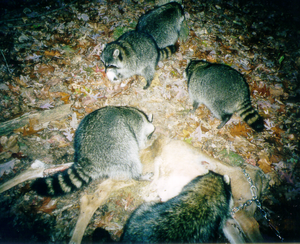 |
| Identifying Animals at Risk from CWD. A raccoon family feeds on a deer carcass staked out by researchers at the University of Wisconsin, in a study aimed at determining which species could be at risk of contracting CWD. (Photo credit: Wikipedia) |
The North Dakota Game and Fish Department is reminding bowhunters that hunting deer over bait is now prohibited in deer units 3C, 3E1, 3E2, 3F1 and 3F2.
Expansion of the area in which hunting over bait is no longer allowed is in response to recent discoveries of chronic wasting disease in deer in part of southwestern North Dakota. In 2011 only unit 3F2, where the first two CWD positive deer were taken, was closed to hunting over bait.
When the third CWD positive deer was taken last fall, Game and Fish began the process to add adjacent units to the ban in an effort to reduce risk for further infected deer to congregate and spread the disease.
“Using a combination of data from winter deer surveys in 2009, 2010 and 2011, new research into the spread of CWD on the landscape conducted in Alberta and Nebraska, and a proactive approach to managing disease, Game and Fish decided to extend the ban on hunting over bait into the deer hunting units surrounding 3F2,” said Department wildlife veterinarian Dr. Dan Grove. “This ban will help reduce the risk of the potential spread of CWD and artificial movement of deer via man-made causes.”
Grove added that the harvest locations of the three CWD-positive animals were clustered within an area in unit 3F2 along major waterways that extend close to surrounding units.
“We started informing the public about this change already last fall,” said Randy Kreil, Game and Fish wildlife division chief. “We talked about it at our advisory board meetings in the western part of the state, and in other forums, as we know it’s a big change and we want people to understand why we feel this is necessary to reduce disease threats to the state’s deer herds.”
Hunting over bait is defined as the placement and/or use of bait(s) for attracting big game and other wildlife to a specific location for the purpose of hunting. Baits include but are not limited to grains, minerals, salts, fruits, vegetables, hay or any other natural or manufactured foods. The designation does not apply to the use of scents and lures, water, food plots, standing crops or livestock feeds used in standard practices.
In addition to the units where hunting over bait is no longer allowed on either private or public land, hunting over bait is also not allowed on most other public land through the state, including state wildlife management areas, U.S. Fish and Wildlife Service national wildlife refuges and waterfowl production areas; U.S. Forest Service national grasslands; and all North Dakota state school, state park and state forest service lands.
These provisions also apply during the deer gun and muzzleloader seasons later this fall.


No comments:
Post a Comment